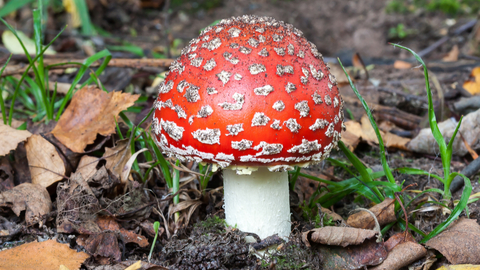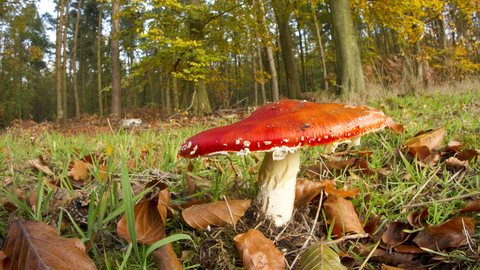
Fly agaric ©Mike Snelle

Fly agaric ©Ben Hall/2020VISION
Fly agaric
Enw gwyddonol: Amanita muscaria
The classic fairy tale toadstool, this red and white fungus is often found beneath birch trees in autumn.
Top facts
Category
Stats
Cap diameter: 8-20cmStem height: 8-18cm
Conservation status
Common
Pryd i'w gweld
August to NovemberYnghylch
Fly agaric is probably our most recognisable species of fungus, with the mushroom's distinctive red cap and white stalk featuring in countless stories, television shows and even video games! Fly agaric is found in woodlands, parks and heaths with scattered trees, typically growing beneath birch trees or pines and spruces. The colourful fruiting bodies can usually be seen between late summer and early winter.Like most fungi, the parts we see are just the fruiting bodies, or mushrooms. These grow up from an unseen network of tiny filaments called hyphae, which together form a structure known as the mycelium. The fruiting bodies produce spores for reproduction, although fungi can also reproduce asexually by fragmentation. The mycelium of fly agaric often forms a symbiotic relationship with the trees around it, wrapping around the roots and supplying them with nutrients taken from the soil. In exchange, the fungus receives sugars produced by the trees.
Fly agarics are poisonous and should not be eaten. Reports of deaths are rare, but ingestion often causes stomach cramps and hallucinations.
What to look for
The distinctive mushrooms have a red cap, either flat or rounded, often with a scattering of white spots or warts, and a white stem. The gills, beneath the cap, are free of the stem.Where to find
WidespreadRoeddech chi yn gwybod?
Despite it being toxic to us, there are some animals that do eat fly agaric. These include red squirrels and slugs, as well as specialists such as fungus gnats - these flies lay eggs on the fungus, and when they hatch the larvae feed on the fruiting body.Gwyliwch
Steve Downer
